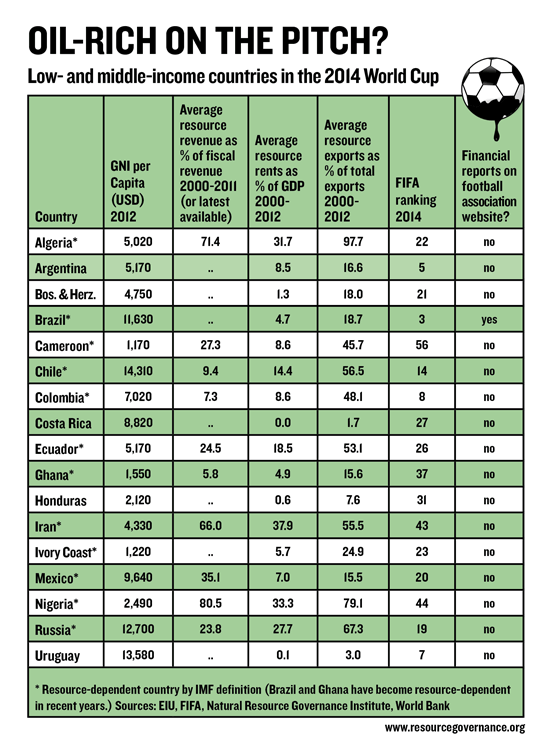
From Oil Field to Football Field: Why Are So Many World Cup Contenders Resource-Dependent?
Qatar’s alleged plot to “buy” the 2022 World Cup has been making global news recently, with salacious stories of bribes paid to African and Caribbean FIFA officials and deals to exchange natural gas for votes. Whether or not the allegations are true, oil revenues made Qatar’s 2022 bid possible. In 2010, Qatar collected over $26 billion in oil and gas revenues and it has approximately $115 billion saved in the Qatar Investment Authority, a sovereign wealth fund. Moreover, Qatar has sufficient proven oil reserves to meet current output levels for at least another 37 years.

At the 2014 World Cup, nearly three-fourths of countries with low and middle incomes are resource-dependent. Above, a Russian team is sponsored by Gazprom, a state-owned gas company.
CC BY-SA 3.0 Степиньш Ольга - http://soccer.ru/gallery/49283
These revenues and savings are helping to finance the $200 billion on new infrastructure to host the event, such as $34 billion on a new rail and underground metro system, $7 billion on a port and $4 billion on new stadiums. Next to this, the millions spent on formal lobbying seem paltry.
Given the magnitude of oil money involved in obtaining the right to host the World Cup, Qatar 2022 might well be called the Oil and Gas Football Tournament. But perhaps it is the current spectacle in Brazil that is the true World Petroleum Cup.
Of the 17 countries competing with a GNI per capita under $15,000 per year, 12 (or 71%) are resource-dependent (see table below). In comparison, approximately 30% of low- or middle-income countries in the world are resource dependent.
Why are resource-rich low- or middle-income countries so overrepresented at the World Cup? There is strong evidence that oil and mineral wealth tends to prolong authoritarian rule and that resource-rich states tend to be controlled by oligarchs. Leaders under these regimes are inclined to prioritize projects that are prestigious over those that generate social or economic returns for the many. Football victories may constitute a significant source of prestige for leaders in resource-rich countries.
The presence of oil and minerals also tends to make government officials and citizens feel richer, leading to more government spending on luxuries like football teams. Often, governments directly finance (generally opaque and unaccountable) football federations, but state-owned oil and mining companies pay for football development directly in several World Cup-bound nations.
The Ghana National Petroleum Company, for instance, sponsors the national team, the Ghana Black Stars. In Algeria, Sonatrach, the national oil company, sponsors the Algerian national football team. Even in Brazil, Petrobras sponsors the Brazilian Men’s Football Cup, which helps develop Brazilian football players.
However, the most unabashed display of patriotism by a state-owned oil or mining company is Gazprom’s football sponsorship program. “Gazprom is not only the largest gas company in the world, but also one of those most passionate about football,” says CEO Alexey Miller. Gazprom sponsors Zenit St Petersburg, the UEFA Champions League and youth football development programs.
International oil, gas or mining companies are also keen to sponsor national football teams. In Guinea, mining company Rio Tinto donated $750,000 to the national football team prior to the 2012 African Cup. Rio Tinto also used to sponsor the Guinean national football league, until the bill and the league’s name were taken over by rival junior Nimba Mining.
Sponsoring an English football club might be more expensive (and more controversial) but not out of reach for a medium-sized company like Tullow Oil. Any business person would tell you this is money well spent: it buys approval by the youth, and some might consider it a critical step in securing a “social license to operate”, especially where extractive operations are likely to have a big economic impact.
But with significant development needs in low- and middle-income resource-rich countries, should either international or state-owned companies be investing in football, or should they spend their revenues on health, education and infrastructure, either via government or corporate social responsibility programs? Resource-rich countries must make a choice: more Maracanas or more Bolsas Familias. As with any classic World Cup match-up, there are supporters on both sides, and a draw is unlikely.
Table: Low- and middle-income countries participating in the 2014 World Cup

